China and climate change: leading with action
China's climate change policies to tackle air pollution are taking shape, but what are they and how can they build a sustainable future?
- China's surge to economic superpower status has come at great cost to the environment
- Air and water pollution in China have been linked to serious health hazards
- China has made large commitments to reducing emissions, promising to reduce GDP carbon intensity by 60–65 % by 2030
- China is taking the lead in renewable energy to meet its commitments, investing USD 126.6bn in 2017 alone and creating enough capacity to power the UK seven times over
- China's shift to renewable energy is part of a highly significant transition that offers a roadmap for developing countries and helps drive technological breakthroughs that will drive down the costs of renewables for consumers everywhere
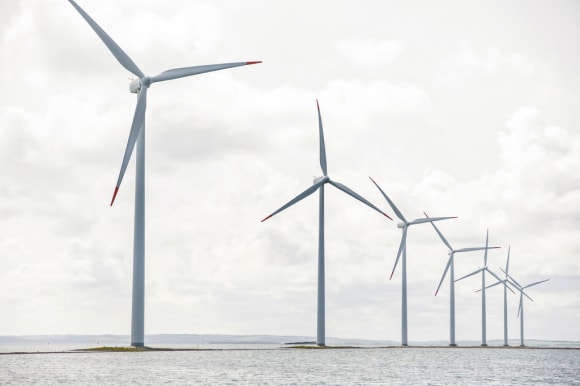
This is a story of transformation. How a country went from being one of the planet's biggest polluters to becoming a world leader on climate action in just one single decade.
China: superpower status but with environmental costs
China: superpower status but with environmental costs
China's surge to economic superpower status from the late twentieth century onwards is well documented. But that growth was coming at a cost.
The country's economic boom was built off manufacturing - a sector which was powered almost entirely by coal. And this dependency was causing problems for China's leaders on three fronts.
China: power sources, 2017
China: power sources, 2017
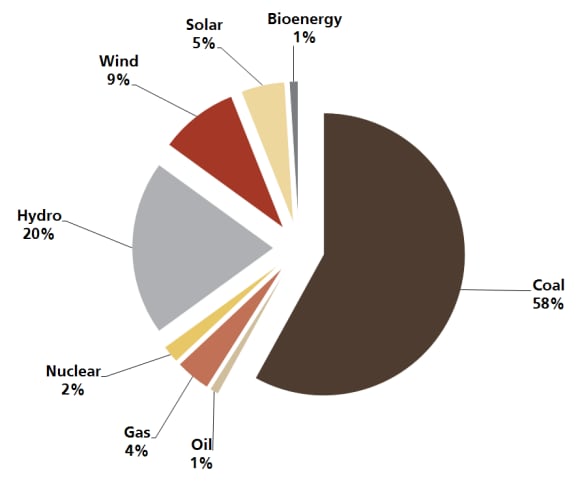
Firstly, domestic coal supplies alone couldn't satisfy the ever-growing demand from the nation's coal-fired power stations. As a result, energy imports were rising.
And as domestic car ownership took off, demand for oil imports rose even further. China had gone from being a net energy exporter to a net energy importer.
China total car ownership (Millions), 2007-2018
China total car ownership (Millions), 2007-2018
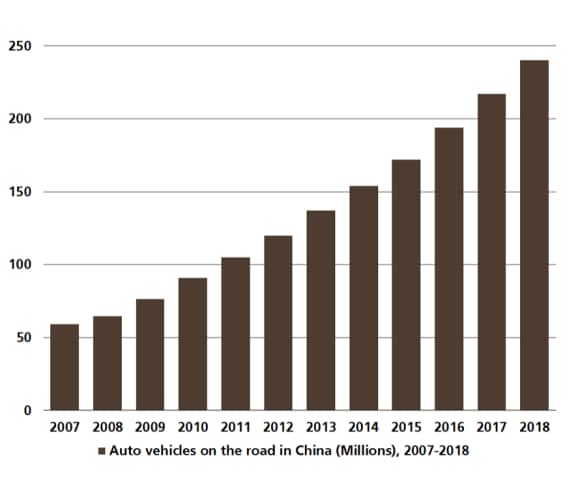
This reliance on imported energy, particularly oil, was posing a serious concern for policy makers. They saw it as a fundamental threat to their nation's energy security, given the reliance on unstable oil producing nations implied by being a net energy importer.
And then there were the immediate, and very visible health effects caused by the widespread use of fossil fuels.
By 2005 China was the world's largest emitter of CO2, leapfrogging the US. Three years later, in 2008, a report from the World Bank revealed that 16 of the world's most polluting cities were to be found in China.
A toxic toll on the nation's health
A toxic toll on the nation's health
The combined effects of coal-fired power stations and a rapidly rising number of vehicles on the road were taking a toxic toll on the nation's health, both literally and financially.
Researchers at Berkeley published a study which found that roughly 17% of all deaths each year were attributable to air pollution.
Meanwhile, estimates from the RAND Corporation suggested that in 2012, air pollution was directly responsible for losses in labor productivity amounting to USD 535 billion, or 6.5 percent of China's gross domestic product.
In the face of such stark statistics, it's not hard to see why China's leaders realized that tackling the health crisis was crucial if they wanted to maintain political support and stability.
Last, but by no means least, the Chinese authorities were heavily focused on economic growth. In economic terms, the old model, characterized by low innovation, low efficiency, an unfavorable industrial structure and a dependency on exports, was simply not going to meet their growth targets. A new, more financially sustainable growth model was called for.
China moves to a sustainable, low-carbon economy
China moves to a sustainable, low-carbon economy
And one way of tackling this three-pronged problem was for the nation's leaders to set their sights on becoming a technological world leader. What better target than renewable energy?
A low-carbon economy could address energy security, improve public health and drive industrial and technological modernization.
And crucially, transitioning effectively to a low-carbon economy also offered China a way of winning its much coveted recognition on the world stage.
It looks like China is succeeding. Even though its original ambitions to be a world leader in climate change may owe more to its need to solve three rather thorny domestic problems, as opposed to an urge to save the planet, no other country has come close to matching China's dominance in transitioning to a low carbon economy.
So, motivations notwithstanding, how has China got to where it is today and what could the future hold?
China has placed the environment firmly front and center of the policy agenda.
Nationally, pollution control sits alongside financial risks and poverty as one of the three national priorities.
That's why the latest Five-Year plan emphasized low-carbon and climate friendly policies, both of which are reflected in local and provincial legislation. Strict laws and standards have been introduced to tackle air, water and soil pollution.
China commits to climate change action
China commits to climate change action
China has also made some ambitious international promises. As part of its commitment under the Paris Agreement, China pledged to reduce the carbon intensity of its GDP by 60–65 % below 2005 levels by 2030.
Given China's position as the second-largest economy in the world, the potential global impact of that undertaking is immense.
And there's one more factor which has helped pave the way for China to become a global climate change leader. President Trump's decision to pull the US out of the Paris Agreement, has paved the way, at a policy level at least, for China to emerge as a clear winner.
While the overall scope of China's commitment to a low-carbon future is wide ranging, the one standout area is its dominance of the renewable energy landscape.
In 2017, China invested USD 127 billion into renewables – almost half the global total and dwarfing the US commitment of USD 41 billion.

Global new investment in renewable energy by region (USD bn), 2017
Global new investment in renewable energy by region (USD bn), 2017
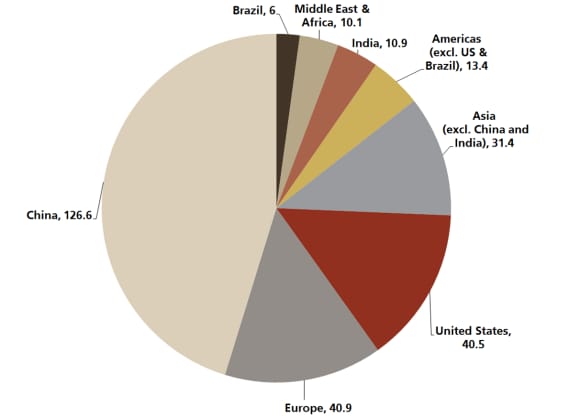
The lion's share of that investment went into solar energy – USD 86.5 billion, followed by wind, to which USD 36 billion was allocated.
Unsurprisingly, that investment has put China at the forefront of the world's solar energy capacity – an astonishing 130 gigawatts – enough to power the United Kingdom several times over if every plant were generating electricity at the same time.
Solar Capacity Compared: New Capacity Added in 2017 & Total Capacity at the end of 2017 (Gigawatts)
Solar Capacity Compared: New Capacity Added in 2017 & Total Capacity at the end of 2017 (Gigawatts)
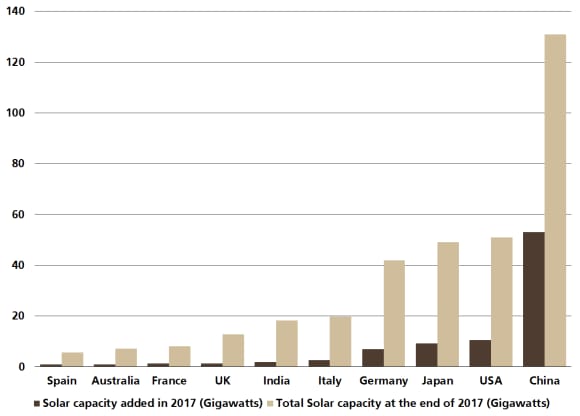
And it's almost certain that a high proportion of those solar panels will have been made in China, given the country manufactures over 60% of the world's solar panels. Leading the pack, according to GTM Research, is CGL New Energy, the world's biggest solar developer.
The cost of solar energy generation has been steadily falling. The World Economic Forum reported that in 2015 the cost of solar had decreased to one sixth of the cost in 2005. In the near future, their forecasts suggest solar power will be less expensive than coal power, a trend which looks set to bring further benefits for Chinese manufacturers.
Solar Power Costs, H2 2014-H2 2018 (USD per watt)
Solar Power Costs, H2 2014-H2 2018 (USD per watt)
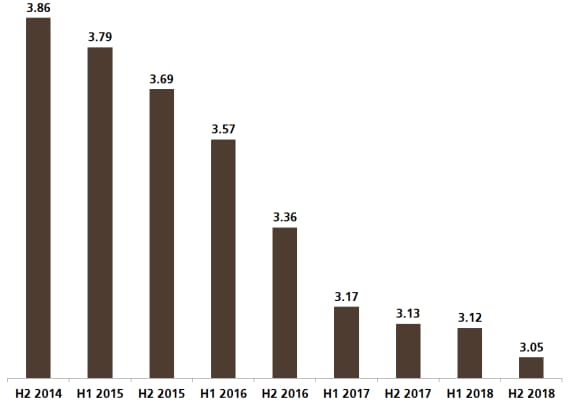
Where next for China's global climate leadership?
Where next for China's global climate leadership?
China is already well on track to achieve the climate targets it set for the Paris Agreement.
It also launched the world’s largest national carbon trading market in 2017 with the objective of encouraging companies to become greener by allowing them sell or buy excessive carbon emissions. The early stages of the project only cover the power generation sector, but in time, the initiative is expected to extend to other areas of the economy.
As China continues to reduce its energy intensity, its experience can offer a roadmap for developing countries. Meanwhile, its investments in renewables, both at home and abroad, can help to drive additional technological breakthroughs that drive down the costs of those renewables for consumers everywhere.
